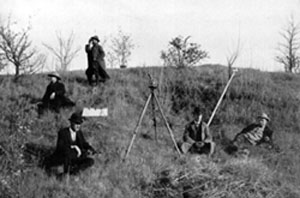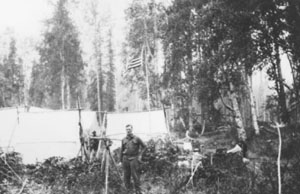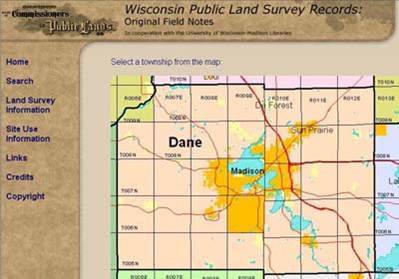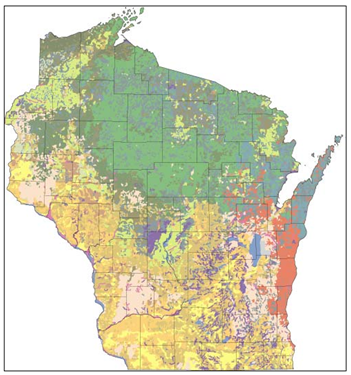 A survey crew taking a break.
A survey crew taking a break.
The PLSS in Wisconsin was put in place essentially continuously beginning in 1832 and concluding in the north in the 1866. Township boundaries were surveyed first; sections were filled in later. A variety of contractors did the work for the General Land Office (GLO). Surveyors followed written “Instructions” from the Surveyor General (located in Cincinnati, OH through 1839, then relocated to Dubuque, IA); instructions changed through the years. A field crew typically was composed of a deputy surveyor (the crew chief), two chainmen (since the distance-measuring device of the day was a chain measuring 66 feet), an axeman/marker, and (in open country) a flagman.
 A camp setup for a surveying team.
A camp setup for a surveying team.
The survey crews’ work was documented in field notebooks. The original notebooks are in custody of Wisconsin’s Board of Commissioner’s of Public Lands. Microfilm copies are held at the State Historical Society. The original notebooks were scanned in 2001 and are viewable over the Internet through a cooperative project of BCPL and the University of Wisconsin-Madison’s General Library System. Due to yellowed paper, faded ink, the florid style of penmanship common during the 19th century, and the use of surveying terminology (often abbreviated), it may be difficult for many people to easily understand the contents of the field notebooks. There is no known comprehensive digital text version of the notebooks; some pages may have been transcribed but there is no index or summary to assist in locating them. Hand written copies were provided to each county around 1900, but these copies may not be retrievable in any particular case.
 Online interface for viewing fieldnotes.
Online interface for viewing fieldnotes.
 Map of the Original Vegetation Cover of Wisconsin.
Map of the Original Vegetation Cover of Wisconsin.
The surveyors not only marked and documented the PLSS as they installed it. They also generally described the countryside and, more specifically, noted the crossing of streams, wetlands, blown-down timber, etc. When setting corners, they often relied on nearby trees as references to the location of the corner. Collectively, these landscape observations represent the earliest systematic information about the state’s vegetation. Careful study of the notebooks can be used to construct vegetation data, although due to the wide spacing between corners it may be impossible to infer what vegetation existed at other points. An interpretation and manual compilation by Finley resulted in a 1:500,000-scale map published in 1976.
